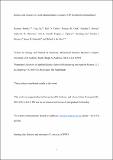Kinetics and structure of a cold-adapted hetero-octameric ATP phosphoribosyltransferase
Abstract
Adenosine 5′-triphosphate phosphoribosyltransferase (ATPPRT) catalyzes the first step in histidine biosynthesis, the condensation of ATP and 5-phospho-α-d-ribosyl-1-pyrophosphate to generate N1-(5-phospho-β-d-ribosyl)-ATP and inorganic pyrophosphate. The enzyme is allosterically inhibited by histidine. Two forms of ATPPRT, encoded by the hisG gene, exist in nature, depending on the species. The long form, HisGL, is a single polypeptide chain with catalytic and regulatory domains. The short form, HisGS, lacks a regulatory domain and cannot bind histidine. HisGS instead is found in complex with a regulatory protein, HisZ, constituting the ATPPRT holoenzyme. HisZ triggers HisGS catalytic activity while rendering it sensitive to allosteric inhibition by histidine. Until recently, HisGS was thought to be catalytically inactive without HisZ. Here, recombinant HisGS and HisZ from the psychrophilic bacterium Psychrobacter arcticus were independently overexpressed and purified. The crystal structure of P. arcticus ATPPRT was determined at 2.34 Å resolution, revealing an equimolar HisGS–HisZ hetero-octamer. Steady-state kinetics indicate that both the ATPPRT holoenzyme and HisGS are catalytically active. Surprisingly, HisZ confers only a modest 2–4-fold increase in kcat. Reaction profiles for both enzymes cannot be distinguished by 31P nuclear magnetic resonance, indicating that the same reaction is catalyzed. The temperature dependence of kcat shows deviation from Arrhenius behavior at 308 K with the holoenzyme. Interestingly, such deviation is detected only at 313 K with HisGS. Thermal denaturation by CD spectroscopy resulted in Tm’s of 312 and 316 K for HisZ and HisGS, respectively, suggesting that HisZ renders the ATPPRT complex more thermolabile. This is the first characterization of a psychrophilic ATPPRT.
Citation
Stroek , R , Ge , Y , Talbot , P D , Glok , M K , Bernas , K E , Thomson , C M , Gould , E R , Alphey , M S , Liu , H , Florence , G J , Naismith , J H & da Silva , R G 2017 , ' Kinetics and structure of a cold-adapted hetero-octameric ATP phosphoribosyltransferase ' , Biochemistry , vol. 56 , no. 5 , pp. 793-803 . https://doi.org/10.1021/acs.biochem.6b01138
Publication
Biochemistry
Status
Peer reviewed
ISSN
0006-2960Type
Journal article
Description
This work was supported by the University of St Andrews and a Leverhulme Trust grant (RL-2012-025) to G.J.F. R.S. was the recipient of an Erasmus Undergraduate Fellowship.Collections
Items in the St Andrews Research Repository are protected by copyright, with all rights reserved, unless otherwise indicated.

